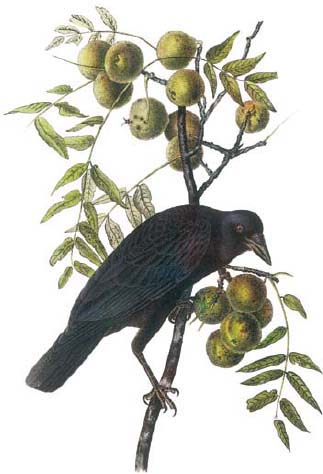

Name: American crow
Species: Corvus brachyrhynchos
Popular and common variants / subspecies / other names: Common crow (Corvus cornix), hooded crow, rook, jackdaw, carrion crow
Geographic distribution: Crows in various forms are found almost worldwide.
Environment: Woodland, cities and urban areas, rural areas, farmland
Physical description: There are about forty different members of this genus. Crows are generally recognized by their glossy black plumage, black beaks, and black legs. The American crow measures approximately 17 inches long, with a wingspan of about 35 inches, and a weight averaging 16 ounces.
Interesting facts: Crows are classified among the world’s most intelligent creatures, being capable of not only tool use but of tool improvisation or construction. They also engage in play, both with one another and with other bird species.
Myths, folklore, and cultural associations: The word cunning could have been created for the Corvidae family. Crows are adaptive, intelligent, and abundant; they are found pretty much everywhere in all kinds of habitats. They are also very social creatures. We use the phrase “as the crow flies” to describe a direct path, a reference to the crow’s ability to go anywhere and do anything.
Most crows eat carrion; they do not kill. Rather, they dine on the remains of animals, or the leftovers of other predators. Crows waste nothing. They serve an important function in the cycle of life, cleaning up and contributing to the easier decomposition of a corpse. This behavior associates them with death in general, as a prophesier of doom and war. In fact, the collective noun for a group of crows is a “murder” of crows.
Crows are often associated with gods and goddesses of war. This is, no doubt, a direct link to the presence of crows at battlefields, ready to dine upon the dead. A classic example of this is the Irish battle goddess the Morrigan, a triple-aspected deity composed of three separate goddesses: Nemain, Badb, and Macha. Badb, in particular, was associated with crows and was said to be able to take the form of a crow to fly over a battlefield.
The relationship with war and death also underlies the crow’s connection to the Otherworld. The crow is sometimes perceived as a harbinger of death as well. The Scots have a term for death: “going away up the Crow Road.” This may be a reference to the folk belief that crows serve as psychopomps, or guides between the world of the living and the afterlife. In Hindu belief, crows serve as intermediaries who bring offerings of food and water to deceased ancestors on the anniversary of the relative’s death, a practice of expressing gratitude known as ´Srˉaddha. In ancient Egypt, however, the crow was a symbol of faithful love because of the bird’s monogamous nature. In Chinese and Japanese mythology, crows are sometimes used as symbols for filial duty.
One of the most famous tales from Aesop’s Fables is that of “The Crow and the Pitcher.” A crow, half dead with thirst, discovers a jug that has only a little bit of water left in it. Unable to reach the water by sticking his head inside, the crow thinks for a moment, then picks up a pebble and drops it into the jug. He repeats this action over and over until the level of the water has risen to the brim of the jug, allowing him to dip his beak in and drink. The moral encoded in the fable teaches that one can accomplish a seemingly impossible task with a series of small actions. However, the story also illustrates the crow’s ability to problem solve and use what tools are at hand to achieve a specific purpose.
Omens and divinatory meaning: How canny are you? How inventive can you be when faced with a seemingly insurmountable challenge? The crow urges you to think outside the box, to examine what tools and skills you have at your disposal, and to apply them in perhaps unconventional ways to achieve your goals.
The crow also teaches you about change. Change is not to be feared; it is part of the natural course of things. The death or end of one thing signifies the birth or beginning of another. Crows teach you about cycles, too. They are carrion birds, and help you to remember that even in death there is something that feeds life. Death is not loss; it is transformation. The crow is also a psychopomp, thus prompting you to think about your connections to the Otherworld. Is your perception of death healthy, or is it problematic? As a psychopomp, the crow accompanies spirits through what many of us see as a difficult journey or change. If you are having trouble handling some sort of change in your life, call on the crow to be your companion through it.
The crow, like the raven, is often portrayed as a trickster figure in Native American mythology. The crow reminds you to have fun while you’re working to understand life and how you fit into the cosmos, which can too often be an overly serious enterprise. Are you denying yourself the opportunity to play?
Associated energies: Death, prophecy, change, play, innovation
Associated seasons: All seasons
Element associations: Earth, air
Color associations: Black, purple